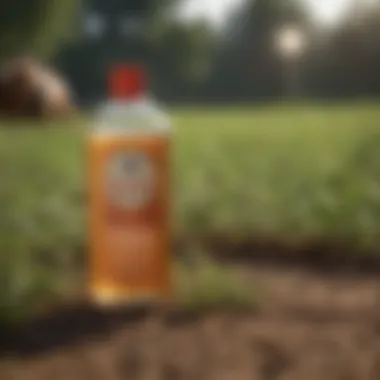Unleashing the Potential of Rodeo Herbicide: A Comprehensive Analysis of Its Active Ingredient


Overview of the Topic
Rodeo herbicide is a potent solution designed to eliminate unwanted vegetation efficiently. This herbicide, through its active ingredient known as glyphosate, offers a powerful method for controlling invasive plant species that threaten natural ecosystems. Understanding the chemical composition and effectiveness of rodeo herbicide is crucial for practitioners in conservation, students studying environmental science, and environmentalists dedicated to preserving ecological balance.
Current Status and Challenges
At present, the application of rodeo herbicide faces scrutiny due to concerns about its impact on non-target plant species and potential environmental repercussions. The indiscriminate use of herbicides like rodeo poses a challenge in maintaining biodiversity within ecosystems. Furthermore, the emergence of herbicide-resistant weeds raises questions about the sustainability and long-term effectiveness of these chemical control methods.
Sustainable Solutions
Exploring sustainable practices in herbicide application involves integrating rodeo herbicide into a holistic approach to weed management. Implementing targeted application techniques and combining herbicidal treatments with natural alternatives can mitigate the adverse effects on non-target species and reduce herbicide resistance. Successful examples of integrated weed management showcase the importance of synergy between chemical and cultural approaches to achieve lasting control over invasive vegetation.
Impact and Importance
The impact of rodeo herbicide extends beyond immediate vegetation control and delves into its implications for ecosystem health and human well-being. Analyzing the cascading effects of herbicide usage on biodiversity, soil quality, and water resources highlights the interconnectedness of environmental systems. Emphasizing the importance of conservation efforts through judicious herbicide application and promoting sustainable resource use are vital for safeguarding ecosystems, supporting communities, and preserving the planet for future generations.
The captivating realm of herbicides unfolds a realm where precision meets potency, unraveling the enigmatic powers of Rodeo Herbicide's active ingredient. This article serves as a beacon, illuminating the effectiveness and nuances of combating unwanted vegetation. From decoding its chemical composition to evaluating environmental ramifications, every layer of this potent herbicide is meticulously dissected for readers seeking scientific comprehension.
Setting the Stage
Overview of Herbicides
Embarking on a journey through the landscape of herbicides, we encounter the formidable aspect of herbicidal agents that redefine weed control methodologies. The crux of understanding herbicides lies in distinguishing their selective or non-selective nature, shaping targeted weed obliteration pathways with unparalleled precision. The holistic perspective on the Overview of Herbicides serves as a cornerstone for cultivating a profound comprehension of herbicidal functionalities within the larger context of agricultural practices.
Importance of Active Ingredients
Delving into the essence of herbicidal efficacy unveils the pivotal role played by active ingredients in defining chemical defoliation processes. Understanding the Importance of Active Ingredients enlightens us on the crucial nuances that govern herbicidal actions, accentuating the significance of meticulously selected compounds for amplifying weed control efficiency. The strategic utilization of active ingredients stands as a crucial determinant in cultivating sustainable herbicidal solutions, underscoring the imperative nature of this component within the herbicidal spectrum.
Brief History of Rodeo Herbicide
Development Timeline
Tracing the evolutionary path of Rodeo Herbicide sets forth a profound narrative depicting its inception, growth, and transformative impact on weed management practices. The Development Timeline unfurls a chronicle marked by strategic innovations and research milestones that have sculpted Rodeo Herbicide into a trailblazer within the herbicidal domain. The evolutionary trajectory of Rodeo Herbicide's development timeline brings to light the commitment to excellence and unwavering dedication epitomized in its journey through the annals of herbicidal advancement.
Key Milestones


Evaluating the key milestones nestled within Rodeo Herbicide's voyage reveals pivotal events that have not merely shaped its identity but have also revolutionized herbicidal paradigms. Each key milestone serves as a testament to Rodeo Herbicide's relentless pursuit of efficacy and environmental conscientiousness, encapsulating breakthrough moments that have propelled it towards unparalleled heights of weed management efficiency. The saga of key milestones within Rodeo Herbicide's expedition accentuates its prowess and indelible impact on modern herbicidal practices, reflecting a legacy driven by innovation and environmental stewardship.
Understanding Rodeo Herbicide
Rodeo herbicide holds a crucial position in the realm of herbicides due to its unique characteristics and potent efficacy. The in-depth exploration of Understanding Rodeo Herbicide delves into its composition, mechanisms, and applications. By dissecting this topic, we uncover the intricate details that make Rodeo herbicide a standout solution for weed management. Understanding the ins and outs of this herbicide is essential for individuals in agriculture, environmental conservation, and botany fields to make informed decisions regarding weed control strategies and environmental impact.
Mechanism of Action
Selective vs. Non-Selective Herbicides
Selective and non-selective herbicides play pivotal roles in weed management strategies, each with distinct properties contributing to their efficacy. Selective herbicides target specific weed species while preserving desired plants, offering precision in weed control. In contrast, non-selective herbicides eliminate a broad spectrum of vegetation without discrimination. Understanding the difference between these herbicidal types is crucial for optimizing weed control methods in various agricultural and ecological contexts, enhancing the effectiveness of herbicide applications in targeted plant management.
Targeted Weed Control
Targeted weed control strategies employ advanced techniques to address weed infestations specifically. By focusing on eradicating identified weed species while minimizing impact on surrounding flora, targeted weed control ensures efficient and environmentally conscious weed management practices. The emphasis on precision in targeting weeds enhances the overall efficacy of herbicidal applications, reducing collateral damage to beneficial plant species and promoting sustainable weed control methodologies.
Formulation
Liquid Concentrate
The formulation of Rodeo herbicide as a liquid concentrate offers practical advantages in herbicidal applications. Liquid concentrates provide ease of handling, storage, and distribution, allowing for accurate dosing and application. This formulation facilitates uniform coverage and absorption on targeted plant surfaces, promoting enhanced herbicidal efficacy. Additionally, liquid concentrates often exhibit improved solubility and bioavailability, further optimizing herbicide performance in controlling unwanted vegetation.
Application Methods
Effective application methods are paramount in maximizing the performance of herbicides like Rodeo in weed management practices. Various application techniques, including spraying, drenching, and spot treatments, cater to specific weed control needs and environmental considerations. Selecting the appropriate application method based on target weed species, growth stage, and infestation level is crucial for achieving optimal herbicidal outcomes. By understanding the nuances of different application methods, practitioners can streamline herbicide use for efficient and sustainable weed control.
Efficacy
Impact on Different Weed Species
The efficacy of Rodeo herbicide varies across different weed species, influenced by factors such as plant physiology, growth habits, and susceptibility to herbicidal ingredients. Understanding the varying responses of diverse weed species to Rodeo herbicide enables effective weed management strategies tailored to target specific plants effectively. By assessing the impact of the herbicide on different weed species, practitioners can refine weed control approaches and optimize herbicidal applications for enhanced efficacy and long-term weed suppression.
Duration of Effectiveness
The duration of effectiveness of Rodeo herbicide is a critical consideration in weed management planning. The longevity of herbicidal effects influences the frequency of application and overall sustainability of weed control efforts. Evaluating the duration of Rodeo herbicide's efficacy on target weeds allows practitioners to prioritize and schedule herbicide applications for maximum impact. By understanding the temporal dynamics of herbicidal effectiveness, users can develop efficient and cost-effective weed control strategies that align with environmental stewardship principles.
The Active Ingredient: Glyphosate


Glyphosate, the active ingredient in Rodeo herbicide, stands as the linchpin of its effectiveness against unwanted vegetation. This powerful chemical compound boasts a molecular structure that enables precise weed control, making it a pivotal element in the realm of herbicides. Its unique properties and composition contribute significantly to its herbicidal potency, allowing for targeted action against specific plant species. The importance of Glyphosate cannot be overstated in the context of herbicidal efficacy and environmental impact.
Chemical Structure
Molecular Composition
The molecular composition of Glyphosate plays a crucial role in its herbicidal properties. Comprising phosphonate, amine, and carboxyl functional groups, Glyphosate demonstrates high water solubility, enabling swift absorption by plant tissues. This characteristic facilitates systemic herbicidal action, ensuring comprehensive weed control. The molecular structure of Glyphosate dictates its mode of action, distinguishing it as a potent herbicidal agent in combating unwanted vegetation.
Bonding Properties
The bonding properties of Glyphosate establish its efficacy in inhibiting the EPSP synthase enzyme essential for amino acid biosynthesis in plants. Its unique capability to form stable complexes with metal ions further enhances its herbicidal activity. The strong bonds formed by Glyphosate with target proteins underscore its effectiveness in disrupting vital plant processes, ensuring consistent weed eradication. While these bonding properties make Glyphosate a formidable herbicide, scrutiny regarding its environmental impact continues to raise pertinent questions.
Mode of Action
Inhibition of EPSP Synthase
The inhibition of EPSP synthase by Glyphosate interferes with the aromatic amino acid synthesis pathway in plants. This disruption leads to the accumulation of shikimic acid, resulting in plant death. The selective inhibition of EPSP synthase in plants underscores the specificity of Glyphosate's mode of action, minimizing collateral damage to non-target species. Despite its efficacy, the potential development of EPSP synthase gene resistance in weed species remains a concern in herbicidal practice.
Disruption of Amino Acid Synthesis
Glyphosate's disruption of amino acid synthesis stems from its interference with the shikimate pathway. By inhibiting the biosynthesis of essential amino acids, Glyphosate impairs protein production in plants, leading to systemic growth inhibition. This mechanism of action contributes to the herbicidal potency of Glyphosate, making it a valuable tool for weed management. It is crucial to consider the long-term implications of Glyphosate use on plant physiology and ecosystem dynamics.
Environmental Impact
Controversies Surrounding Glyphosate
Controversies surrounding Glyphosate primarily revolve around its classification as a potential carcinogen and its widespread environmental presence. The debate regarding Glyphosate's safety and regulatory considerations continues to spark discourse among scientists, policymakers, and environmentalists worldwide. Mitigating the potential risks associated with Glyphosate exposure remains a critical challenge in modern herbicidal practices.
Ecological Considerations
Ecological considerations pertaining to Glyphosate usage encompass its impact on non-target plant species, soil microbiota, and aquatic ecosystems. The persistence of Glyphosate residues in the environment poses threats to biodiversity and ecosystem health, necessitating stringent monitoring and mitigation strategies. Balancing the herbicidal efficacy of Glyphosate with its environmental consequences remains a pivotal issue in sustainable agricultural practices.
Safety and Regulations
In the realm of herbicides, the focus on safety and regulations plays a pivotal role in ensuring environmental stewardship and human health protection. The meticulous adherence to guidelines not only safeguards agricultural practices but also minimizes adverse effects on ecosystems. Within this article, the segment of Safety and Regulations delves deep into the stringent protocols and standards essential for the effective and responsible use of herbicides like Rodeo. By exploring this aspect, readers gain a profound appreciation for the intricate balance between maximizing herbicidal efficiency and preserving the ecological equilibrium.


Usage Guidelines
Dosage Recommendations
Dosage Recommendations constitute a cornerstone in the prudent application of herbicides, symbolizing a critical element in achieving optimal results while averting potential risks. When it comes to Rodeo Herbicide, dosing instructions are meticulously crafted to align with diverse vegetation types and environmental considerations, ensuring precise and targeted weed control. The emphasis on Dosage Recommendations within this article underscores its significance in guiding farmers and land managers towards sustainable herbicidal practices, promoting efficacy without compromising environmental integrity.
Precautionary Measures
The integration of Precautionary Measures into herbicidal protocols epitomizes a proactive approach towards averting undesirable consequences that may arise from chemical applications. With a specific focus on Rodeo Herbicide, these measures encapsulate a spectrum of anticipatory actions geared towards safeguarding human well-being and ecological balance. This article highlights the paramount importance of embracing Precautionary Measures as an indispensable component of herbicide implementation, offering insights into mitigating potential risks and upholding safety standards with unwavering commitment.
Environmental Policies
EPA Regulations
EPA Regulations stand as the cornerstone of environmental stewardship in herbicide usage, outlining directives that govern product registration, labeling, and overall environmental impact assessment. Within the context of this article, the exploration of EPA Regulations sheds light on the stringent measures in place to ensure the judicious application of Rodeo Herbicide, underlining the significance of regulatory compliance in preserving biodiversity and ecosystem health. By elucidating the nuances of EPA Regulations, readers gain a profound understanding of the regulatory landscape surrounding herbicidal practices, fostering informed decision-making and sustainable agricultural strategies.
International Standards
International Standards serve as a benchmark for harmonizing herbicidal practices on a global scale, promoting consistency in guidelines and fostering cross-border collaborations in environmental protection. Within the discourse of this article, the scrutiny of International Standards delineates the shared commitments of nations towards endorsing safe and sustainable herbicide usage, transcending geographical boundaries for the greater good of the planet. By delineating the nuances of International Standards, this segment empowers readers with a comprehensive outlook on the collective efforts towards preserving environmental integrity and fostering consensus-driven approaches in herbicidal regulations.
Future Perspectives
In discussing the future perspectives of herbicides, particularly in the context of the comprehensive exploration of Rodeo Herbicide, it is imperative to consider the evolving landscape of agricultural practices. The advancement in herbicide technology has paved the way for innovative approaches that prioritize sustainability and efficiency. By delving into the future prospects of herbicides, this article aims to showcase the transformative potential that lies ahead in weed management and agricultural sustainability.
Innovations in Herbicide Technology
Biological Alternatives
Exploring the realm of biological alternatives in herbicide technology unveils a groundbreaking shift towards eco-friendly and biodegradable solutions. The emphasis on utilizing natural components and organisms to combat weeds represents a paradigm shift in herbicidal practices. Biological alternatives, with their inherent biocompatibility and reduced environmental impact, stand as a promising choice for sustainable weed control. The unique feature of biological alternatives lies in their ability to target specific weed species while preserving the surrounding ecosystem. Despite their advantages in eco-conscious farming practices, these alternatives may pose challenges in terms of efficacy and cost-effectiveness.
Precision Agriculture
Precision agriculture revolutionizes herbicide application through data-driven decision-making and targeted treatments. The key characteristic of precision agriculture lies in its precise and site-specific approach to weed management, optimizing resource utilization and minimizing environmental footprint. This method offers a beneficial choice for integrating herbicide use with advanced technologies, enhancing overall efficiency and efficacy. The unique feature of precision agriculture is its ability to tailor herbicide application to individual crop requirements, ensuring customized solutions for weed control. While precision agriculture offers significant advantages in reducing herbicide wastage and increasing productivity, challenges such as initial investment costs and technological barriers may limit widespread adoption.
Sustainability Practices
Integrated Weed Management
Integrating weed management practices emphasizes a holistic approach that combines cultural, mechanical, biological, and chemical strategies. The key characteristic of integrated weed management lies in its comprehensive and multidimensional weed control techniques, minimizing herbicide reliance and promoting long-term sustainability. This method provides a beneficial choice for addressing weed resistance issues and preserving ecosystem balance. The unique feature of integrated weed management is its ability to disrupt weed life cycles through diverse control measures, reducing dependence on herbicides over time. While offering advantages in sustainable weed control, challenges such as complexity in implementation and initial transition may deter widespread adoption.
Organic Farming Solutions
Organic farming solutions present a natural and chemical-free approach to weed management, aligning with the principles of ecological balance and soil health. The key characteristic of organic farming solutions lies in their reliance on natural inputs and biological control methods, fostering biodiversity and soil fertility. This method proves to be a beneficial choice for consumers seeking pesticide-free produce and farmers committed to environmental stewardship. The unique feature of organic farming solutions is their ability to enhance soil structure and microbial activity, promoting long-term agricultural sustainability. Despite the advantages in promoting environmental health and premium produce, challenges such as lower yields and transition periods may pose obstacles to widespread adoption.



